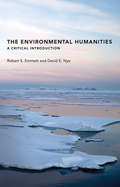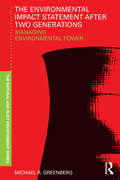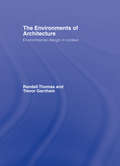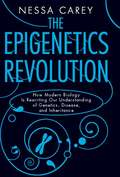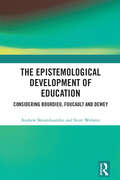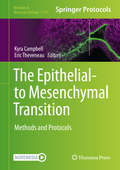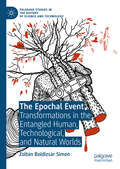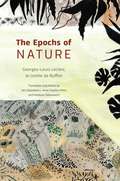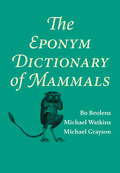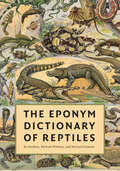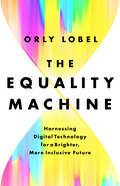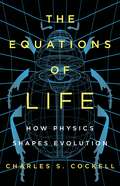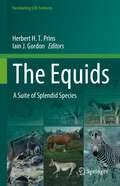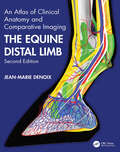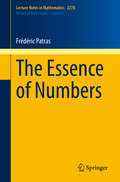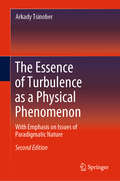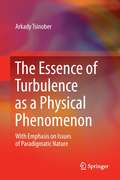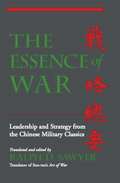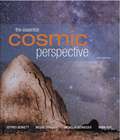- Table View
- List View
The Environmental Humanities: A Critical Introduction (The\mit Press Ser. #1)
by David E. Nye Robert S. EmmettA concise overview of this multidisciplinary field, presenting key concepts, central issues, and current research, along with concrete examples and case studies.The emergence of the environmental humanities as an academic discipline early in the twenty-first century reflects the growing conviction that environmental problems cannot be solved by science and technology alone. This book offers a concise overview of this new multidisciplinary field, presenting concepts, issues, current research, concrete examples, and case studies. Robert Emmett and David Nye show how humanists, by offering constructive knowledge as well as negative critique, can improve our understanding of such environmental problems as global warming, species extinction, and over-consumption of the earth's resources. They trace the genealogy of environmental humanities from European, Australian, and American initiatives, also showing its cross-pollination by postcolonial and feminist theories. Emmett and Nye consider a concept of place not synonymous with localism, the risks of ecotourism, and the cultivation of wild areas. They discuss the decoupling of energy use and progress, and point to OECD countries for examples of sustainable development. They explain the potential for science to do both good and harm, examine dark visions of planetary collapse, and describe more positive possibilities—alternative practices, including localization and degrowth. Finally, they examine the theoretical impact of new materialism, feminism, postcolonial criticism, animal studies, and queer ecology on the environmental humanities.
The Environmental Impact Statement After Two Generations: Managing Environmental Power (Natural and Built Environment Series)
by Michael R. GreenbergThis book is about a subject that Michael Greenberg has worked on and lived with for almost forty years. He was brought up in the south Bronx at a time when his neighborhood suffered from terrible air and noise pollution, and domestic waste went untreated into the Hudson River. For him, the National Environmental Policy Act (NEPA) was a blessing. It included an ethical position about the environment, and the law required some level of accountability in the form of an environmental impact statement, or EIS. After forty years of thinking about and working with NEPA and the EIS process, Greenberg decided to conduct his own evaluation from the perspective of a person trained in science who focuses on environmental and environmental health policies. This book of carefully chosen real case studies goes beyond the familiar checklists of what to do, and shows students and practitioners alike what really happens during the creation and implementation of an EIS.
The Environments of Architecture: Environmental Design in Context
by Randall Thomas Trevor GarnhamThis well-illustrated 'think piece' provides a much needed and topical philosophical introduction to the place of environmental design in architecture. The Environments of Architecture sets out a range of considerations necessary to produce appropriate internal environments in the context of a wider discussion on the effect of building decisions on the broader environment. The authors, from architecture and engineering, academia and practice, provide a rounded and well-balanced introduction to this important topic. Starting from a belief that the built environment can contribute more positively to the planet and the pleasure of places as well as answering the practical demands of comfort, they cover site planning, form, materials, construction and operation as well as looking at design on a city level. Presenting a thoughtful and stimulating approach to the built environment, this book forms an excellent guide for practitioners, students and academics concerned with our built environment.
The Environments of the Sun and the Stars
by Coralie Neiner Jean-Pierre RozelotBased on lectures given at a CNRS summer school in France, this book covers many aspects of stellar environments (both observational and theoretical) and offers a broad overview of the field. More specifically, Part I of the book focuses on the Sun, the properties of the ejected plasma, of the solar wind and on space weather. The second part deals with tides in planetary systems and in binary stellar systems, as well as with interactions in massive binary stars as seen by interferometry. Finally the chapters of Part III discuss the environments of young or evolved stars, stellar winds, agnetic fields and disks. With its broad approach the book will provide advanced students as well as researchers with a good overview of the environments of the Sun and the stars.
The Epigenetics Revolution: How Modern Biology Is Rewriting Our Understanding of Genetics, Disease, and Inheritance
by Nessa CareyEpigenetics can potentially revolutionize our understanding of the structure and behavior of biological life on Earth. It explains why mapping an organism's genetic code is not enough to determine how it develops or acts and shows how nurture combines with nature to engineer biological diversity. Surveying the twenty-year history of the field while also highlighting its latest findings and innovations, this volume provides a readily understandable introduction to the foundations of epigenetics.Nessa Carey, a leading epigenetics researcher, connects the field's arguments to such diverse phenomena as how ants and queen bees control their colonies; why tortoiseshell cats are always female; why some plants need cold weather before they can flower; and how our bodies age and develop disease. Reaching beyond biology, epigenetics now informs work on drug addiction, the long-term effects of famine, and the physical and psychological consequences of childhood trauma. Carey concludes with a discussion of the future directions for this research and its ability to improve human health and well-being.
The Epigenetics Revolution: How Modern Biology is Rewriting Our Understanding of Genetics, Disease, and Inheritance
by Nessa CareyEpigenetics can potentially revolutionize our understanding of the structure and behavior of biological life on Earth. It explains why mapping an organism’s genetic code is not enough to determine how it develops or acts and shows how nurture combines with nature to engineer biological diversity. Surveying the twenty-year history of the field while also highlighting its latest findings and innovations, this volume provides a readily understandable introduction to the foundations of epigenetics. Nessa Carey, a leading epigenetics researcher, connects the field’s arguments to such diverse phenomena as how ants and queen bees control their colonies; why tortoiseshell cats are always female; why some plants need cold weather before they can flower; and how our bodies age and develop disease. Reaching beyond biology, epigenetics now informs work on drug addiction, the long-term effects of famine, and the physical and psychological consequences of childhood trauma. Carey concludes with a discussion of the future directions for this research and its ability to improve human health and well-being.
The Epistemological Development of Education: Considering Bourdieu, Foucault and Dewey
by Scott Webster Andrew SkourdoumbisThis book documents the political and economic ramifications of the policy impetus for a ‘science of education’ and what this means for classroom teachers, their teaching practices and for the field of education. In a critical exploration of current research and policy articulations of the purposes of education, with attention given to Australia, the UK and the USA, this book delineates the evaluative mechanisms involved in the strategic science as method adoption of accountability, competitiveness and test-driven criteria used in major education policy. It brings together the disciplines of sociology and philosophy by drawing on the theoretical insights of Michel Foucault, Pierre Bourdieu and John Dewey. In addition, the book argues for the deliberate use of the theoretical in education and is against the contemporary unquestioning advocacy that often accompanies a narrowly defined master narrative of a science of education. This book will be of special interest to post-graduate students as source material in general education courses and is also intended for academics with an interest in educational theory/philosophy and the sociology of education.
The Epithelial-to Mesenchymal Transition: Methods and Protocols (Methods in Molecular Biology #2179)
by Kyra Campbell Eric TheveneauThis volume details a comprehensive range of methods for imaging epithelial-to-mesechymal transition (EMT)/MET in in vivo systems, and methods to leverage these systems to dissect the underlying mechanisms. Chapters guide readers through studying different features of epithelial-mesenchymal plasticity, past and future research of the EMT, in vivo systems, and in vivo imaging. Written in the highly successful Methods in Molecular Biology series format, chapters include introductions to their respective topics, lists of the necessary materials and reagents, step-by-step, readily reproducible laboratory protocols, and tips on troubleshooting and avoiding known pitfalls. Authoritative and cutting-edge, The Epithelial-to Mesenchymal Transition: Methods and Protocols aims to provide methods in EMT will help to unite and drive research in this exciting field forwards.
The Epochal Event: Transformations in the Entangled Human, Technological, and Natural Worlds (Palgrave Studies in the History of Science and Technology)
by Zoltán Boldizsár SimonThis book is a unique attempt to capture the growing societal experience of living in an age unlike anything the world has ever seen. Fueled by the perception of acquiring unprecedented powers through technologies that entangle the human and the natural worlds, human beings have become agents of a new kind of transformative event. The ongoing sixth mass extinction of species, the prospect of a technological singularity, and the potential crossing of planetary boundaries are expected to trigger transformations on a planetary scale that we deem catastrophic and try to avoid. In making sense of these prospects, Simon’s book sketches the rise of a new epochal thinking, introduces the epochal event as an emerging category of a renewed historical thought, and makes the case for the necessity of bringing together the work of the human and the natural sciences in developing knowledge of a more-than-human world.
The Epochs of Nature
by Georges-Louis Leclerc Libby Robin Jan Zalasiewicz Anne-Sophie Milon Mateusz Zalasiewicz Sverker Sörlin Jacques GrinevaldGeorges-Louis Leclerc, le comte de Buffon's The Epochs of Nature, originally published as Les Époques de la Nature in 1778, is one of the first great popular science books, a work of style and insight that was devoured by Catherine the Great of Russia and influenced Humboldt, Darwin, Lyell, Vernadsky, and many other renowned scientists. It is the first geological history of the world, stretching from the Earth’s origins to its foreseen end, and though Buffon was limited by the scientific knowledge of his era—the substance of the Earth was not, as he asserts, dragged out of the sun by a giant comet, nor is the sun’s heat generated by tidal forces—many of his deductions appear today as startling insights. And yet, The Epochs of Nature has never before been available in its entirety in English—until now. In seven epochs, Buffon reveals the main features of an evolving Earth, from its hard rock substrate to the sedimentary layers on top, from the minerals and fossils found within these layers to volcanoes, earthquakes, and rises and falls in sea level—and he even touches on age-old mysteries like why the sun shines. In one of many moments of striking scientific prescience, Buffon details evidence for species extinction a generation before Cuvier’s more famous assertion of the phenomenon. His seventh and final epoch does nothing less than offer the first geological glimpse of the idea that humans are altering the very foundations of the Earth—an idea of remarkable resonance as we debate the designation of another epoch: the Anthropocene. Also featuring Buffon’s extensive “Notes Justificatives,” in which he offers further evidence to support his assertions (and discusses vanished monstrous North American beasts—what we know as mastodons—as well as the potential existence of human giants), plus an enlightening introduction by editor and translator Jan Zalasiewicz and historians of science Sverker Sörlin, Libby Robin, and Jacques Grinevald, this extraordinary new translation revives Buffon’s quite literally groundbreaking work for a new age.
The Eponym Dictionary of Mammals
by Michael Watkins Bo Beolens Michael GraysonJust who was the Przewalski after whom Przewalski's horse was named? Or Husson, the eponym for the rat Hydromys hussoni? Or the Geoffroy whose name is forever linked to Geoffroy's cat? This unique reference provides a brief look at the real lives behind the scientific and vernacular mammal names one encounters in field guides, textbooks, journal articles, and other scholarly works.Arranged to mirror standard dictionaries, the more than 1,300 entries included here explain the origins of over 2,000 mammal species names. Each bio-sketch lists the scientific and common-language names of all species named after the person, outlines the individual's major contributions to mammalogy and other branches of zoology, and includes brief information about his or her mammalian namesake's distribution. The two appendixes list scientific and common names for ease of reference, and, where appropriate, individual entries include mammals commonly—but mistakenly—believed to be named after people.The Eponym Dictionary of Mammals is a highly readable and informative guide to the people whose names are immortalized in mammal nomenclature.
The Eponym Dictionary of Mammals
by Michael Watkins Bo Beolens Michael GraysonLearn the origins of over 2,000 mammal species names with this informative reference guide.Just who was the Przewalski after whom Przewalski's horse was named? Or Husson, the eponym for the rat Hydromys hussoni? Or the Geoffroy whose name is forever linked to Geoffroy's cat? This unique reference provides a brief look at the real lives behind the scientific and vernacular mammal names one encounters in field guides, textbooks, journal articles, and other scholarly works.Arranged to mirror standard dictionaries, the more than 1,300 entries included here explain the origins of over 2,000 mammal species names. Each bio-sketch lists the scientific and common-language names of all species named after the person, outlines the individual’s major contributions to mammalogy and other branches of zoology, and includes brief information about his or her mammalian namesake’s distribution. The two appendixes list scientific and common names for ease of reference, and, where appropriate, individual entries include mammals commonly—but mistakenly—believed to be named after people.The Eponym Dictionary of Mammals is a highly readable and informative guide to the people whose names are immortalized in mammal nomenclature.“A small treasure trove of information about the people whose names are immortalized in mammalian nomenclature. Given that we mammalogists are prone to ancestor worship, I expect it to be a best-seller.” —Don E. Wilson, Journal of Mammalian Evolution“This is a great reference for the mammalogy professional or student, or the curious naturalist.” —Wildlife Activist“This is a splendid book which fills a real gap in zoological literature.” —Nicholas Gould, International Zoo News
The Eponym Dictionary of Reptiles
by Michael Watkins Bo Beolens Michael GraysonWho was Richard Kemp, after whom the Kemp’s ridley sea turtle is named? Is Wake’s Gecko named after Berkeley’s Marvalee Wake? Or perhaps her husband, David? Why do so many snakes and lizards have Werner in their name? This reference book answers these and thousands of other questions about the origins of the vernacular and scientific names of reptiles across the globe.From Agkistrodon piscivorus conanti, the Florida cottonmouth subspecies named for Roger Conant, to Xantusia, the night lizard genera namesake of John Xantus, this dictionary covers everyone after whom an extant or recently extinct reptile has been named. The entries include a brief bio-sketch, a list of the reptiles that bear the individual’s name, the names of reptiles erroneously thought to be associated with the person, and a summary of major—and sometimes obscure or even incidental—contributions made by the person to herpetology and zoology. An introductory chapter explains how to use the book and describes the process of naming taxa. Easy to use and filled with addictive—and highly useful—information about the people whose names will be carried into the future on the backs of the world’s reptiles, The Eponym Dictionary of Reptiles is a handy and fun book for professional and amateur herpetologists alike.
The Equality Machine: Harnessing Digital Technology for a Brighter, More Inclusive Future
by Orly LobelAN ECONOMIST BEST BOOK OF 2022 At a time when AI and digital platforms are under fire, Orly Lobel, a renowned tech policy scholar, defends technology as a powerful tool we can harness to achieve equality and a better future. Much has been written about the challenges tech presents to equality and democracy. But we can either criticize big data and automation or steer it to do better. Lobel makes a compelling argument that while we cannot stop technological development, we can direct its course according to our most fundamental values. With provocative insights in every chapter, Lobel masterfully shows that digital technology frequently has a comparative advantage over humans in detecting discrimination, correcting historical exclusions, subverting long-standing stereotypes, and addressing the world&’s thorniest problems: climate, poverty, injustice, literacy, accessibility, speech, health, and safety. Lobel's vivid examples—from labor markets to dating markets—provide powerful evidence for how we can harness technology for good. The book&’s incisive analysis and elegant storytelling will change the debate about technology and restore human agency over our values.
The Equations of Life: How Physics Shapes Evolution
by Charles S. CockellA groundbreaking argument for why alien life will evolve to be much like life here on EarthWe are all familiar with the popular idea of strange alien life wildly different from life on earth inhabiting other planets. Maybe it's made of silicon! Maybe it has wheels! Or maybe it doesn't. In The Equations of Life, biologist Charles S. Cockell makes the forceful argument that the laws of physics narrowly constrain how life can evolve, making evolution's outcomes predictable. If we were to find on a distant planet something very much like a lady bug eating something like an aphid, we shouldn't be surprised. The forms of life are guided by a limited set of rules, and as a result, there is a narrow set of solutions to the challenges of existence.A remarkable scientific contribution breathing new life into Darwin's theory of evolution, The Equations of Life makes a radical argument about what life can--and can't--be.
The Equids: A Suite of Splendid Species (Fascinating Life Sciences)
by Herbert H. T. Prins Iain J. GordonThe narrative of the progression of the ‘horse family’ through geological time, from dog-sized fruit-eating animals with four toes on their front and three toes on their hind legs, to the valiant long-legged, single-toed modern grazing horses, beloved by racing enthusiasts, is the poster child of evolution. However, like the rhinos or tapirs, the horse-like zebras, wild asses, kulans, kiangs, onagers, and the real horses are often portrayed as being past their evolutionary peak as compared to the more recently evolved ruminants (especially bovids and deer) which now dominate the grazing niche. That story of a species group over its evolutionary zenith is compelling, but anyone who has travelled in the remote savannas of Africa or the cold wild deserts of Central Asia is awed with herds of glorious animals that clearly do not ruminate. It appears as though these, so-named ‘hind-gut fermenters’, are perhaps much better adapted to these environments than one is led to believe. The purpose of this book is to dispel the myth of the inferior Equidae by describing, and investigating, the evolutionary and ecological journey of the horse family in all its glory.
The Equine Distal Limb: An Atlas of Clinical Anatomy and Comparative Imaging
by Jean-Marie DenoixJean-Marie Denoix is the world’s leading equine musculoskesletal system anatomist and has become one of the foremost equine diagnostic ultrasonographers. There is therefore nobody better to compile a reference atlas of the clinical anatomy of the foot, pastern and fetlock, correlated with images obtained by radiography, diagnostic ultrasonography and magnetic resonance imaging. Advanced imaging techniques require in-depth knowledge of anatomy for accurate interpretation and, especially when using magnetic resonance imaging, this must be a three-dimensional concept of anatomy.This new edition replaces ultrasound images and most of the radiographic and MRI images with new, updated versions and adds brand new images of extraordinarily high quality. The multiple views of each area of the distal limb provide an extremely detailed evaluation, while every part opens with an anatomical drawing by the author. Each double-page spread deals with a single dissection viewed by means of colour photographs, labelled B&W equivalents, plus x-rays, ultrasound and MRI scans as required.Diagnosis and management of distal limb lameness require a precise knowledge of the functional anatomy and biomechanics of the equine distal joints, ligaments and tendons, presented in the last chapter. The atlas is designed for maximum clarity using a generous page size and is essential for anybody involved in detailed anatomical study, complex lameness evaluation or advanced imaging techniques.
The Essence of Numbers (Lecture Notes in Mathematics #2278)
by Frédéric PatrasThis book considers the manifold possible approaches, past and present, to our understanding of the natural numbers. They are treated as epistemic objects: mathematical objects that have been subject to epistemological inquiry and attention throughout their history and whose conception has evolved accordingly. Although they are the simplest and most common mathematical objects, as this book reveals, they have a very complex nature whose study illuminates subtle features of the functioning of our thought. Using jointly history, mathematics and philosophy to grasp the essence of numbers, the reader is led through their various interpretations, presenting the ways they have been involved in major theoretical projects from Thales onward. Some pertain primarily to philosophy (as in the works of Plato, Aristotle, Kant, Wittgenstein...), others to general mathematics (Euclid's Elements, Cartesian algebraic geometry, Cantorian infinities, set theory...). Also serving as an introduction to the works and thought of major mathematicians and philosophers, from Plato and Aristotle to Cantor, Dedekind, Frege, Husserl and Weyl, this book will be of interest to a wide variety of readers, from scholars with a general interest in the philosophy or mathematics to philosophers and mathematicians themselves.
The Essence of Turbulence as a Physical Phenomenon: With Emphasis On Issues Of Paradigmatic Nature
by Arkady TsinoberNow in its second edition, this book clearly, concisely and comprehensively outlines the essence of turbulence. In view of the absence of a theory based on first principles and adequate tools to handle the problem, the “essence” of turbulence, i.e. what turbulence really is from a fundamental point of view, is understood empirically through observations from nature, laboratories and direct numerical simulations rather than explained by means of conventional formalistic aspects, models, etc., resulting in pertinent issues being described at a highly theoretical level in spite of the mentioned lack of theory.As such, the book highlights and critically reexamines fundamental issues, especially those of paradigmatic nature, related to conceptual and problematic aspects, key misconceptions and unresolved matters, and discusses why the problem is so difficult. As in the previous edition, the focus on fundamental issues is also a consequence of the view that without corresponding advances in fundamental aspects there is little chance of progress in any applications. More generally there is a desperate need for physical fundamentals of a great variety of processes in nature and technology in which turbulence plays a central role. Turbulence is omnipresent throughout the natural sciences and technology, but despite the vast sea of information available the book retains its brevity without oversimplifications, making it of interest to a broad audience.
The Essence of Turbulence as a Physical Phenomenon: With Emphasis on Issues of Paradigmatic Nature
by Arkady TsinoberThis book critically reexamines what turbulence really is, from a fundamental point of view and based on observations from nature, laboratories, and direct numerical simulations. It includes critical assessments and a comparative analysis of the key developments, their evolution and failures, along with key misconceptions and outdated paradigms. The main emphasis is on conceptual and problematic aspects, physical phenomena, observations, misconceptions and unresolved issues rather than on conventional formalistic aspects, models, etc. Apart from the obvious fundamental importance of turbulent flows, this emphasis stems from the basic premise that without corresponding progress in fundamental aspects there is little chance for progress in applications such as drag reduction, mixing, control and modeling of turbulence. More generally, there is also a desperate need to grasp the physical fundamentals of the technological processes in which turbulence plays a central role.
The Essence of War: Leadership and Strategy from the Chinese Military Classics
by Ralph D. SawyerFrom antiquity, the history of China has been marked by invading tribes, warring states, and popular uprisings. This heritage of conflict produced a body of martial literature exploring the fundamental principles of warfare and their methods of employment. Fully aware of the tragic consequences of battle, the authors of these texts emphasized that bloodshed and war should be avoided whenever possible. But, they argued, this is possible only when the principles of leadership and strategy have been mastered and the dynamics of conflict thoroughly analyzed. Over the centuries, these texts have been studied throughout Asia, not only by generals on the battlefield but by leaders of all kinds concerned with the management of human conflict in all its forms. The Essence of War presents eight of these classics (written from 500 B. C. E. to 700 C. E. ), including Sun-tzu's Art of War and Sun Pin's Military Methods. The book introduces the core principles of Chinese military science, grouping selected passages and key quotations into five thematic sections encompassing forty-one topical chapters: Fundamentals, Tao of Warfare, Tao of Command, Tactical Essentials, and Tactical Specifics. Translator Ralph D. Sawyer provides here a concise introduction to Chinese military thought and influential materials not only of traditional import, but also for contemporary study and enduring value in both business and military circles throughout the world.
The Essential Book of Fermentation
by Jeff CoxThe country's leading expert on organic food delivers the ultimate guide to the new culinary health movement--feasting on fermented probiotics, from artisanal cheese to kimchi. In his extensive career as a bestselling cookbook author and TV garden-show host, Jeff Cox has always been keenly aware of the microbiology that helps his garden flourish. He has long known that microbes keep our bodies healthy as they ferment food, releasing their nutritional power and creating essential vitamins and enzymes. In The Essential Book of Fermentation, Cox shares a bounty of recipes for nourishing the internal "garden." Simplifying the art and science of fermentation, Cox offers a primer on the body's microbial ecosystem, complemented by scrumptious recipes, and easy-to-follow pickling and canning techniques. Basics such as bread and yogurt help readers progress to wine, cheese, and a host of international delicacies, including kim chi and chow chow. Inspiring and innovative, The Essential Book of Fermentation serves up great taste along with great health on every page.
The Essential Cosmic Perspective
by Jeffrey Bennett Mark Voit Nicholas Schneider Megan Donahue<P><P>A practical introduction to Astronomy with an emphasis on critical thinking about our place in the universe <P><P>This 8th Edition of Essential Cosmic Perspective provides readers without science backgrounds with a streamlined, cutting-edge introduction to astronomy. Built on a strong tradition of effective pedagogy and coverage, the text focuses on skill-building and includes group work exercises that require active participation. Dedicated to bringing an understanding of the universe, its scientific basis and its relevance to our lives, each chapter is written to specific learning goals that build an ideal learning path for readers. Aiming to foster a lifelong learning experience, the authors focus on key concepts, providing big picture context, promoting conceptual understanding, and preferring plain language to jargon. <P><P>The 8th Edition incorporates the latest scientific updates in the field of astronomy and includes new features that reinforce critical thinking and excite readers’ curiosity. New features such as Extraordinary Claims engage readers by presenting extraordinary claims about the universe and how they were either supported or debunked as scientists collected more evidence, reinforcing the process of science and how scientists think critically to evaluate them. My Cosmic Perspective establishes a personal connection between readers and the cosmos as they learn to think critically about the meaning of what they learn in their astronomy studies and beyond. Designed and written for a one semester course, this text shares many of the strengths of its more comprehensive best-selling sibling, The Cosmic Perspective.
The Essential Cosmic Perspective
by Jeffrey O. Bennett Mark Voit Nicholas Schneider Megan Donahue<p>The Essential Cosmic Perspective is designed as a textbook for college courses in introductory astronomy, but is suitable for any¬one who is curious about the universe. We assume no prior knowledge of astronomy or physics, and the book is especially written for students who do not intend to major in mathematics or science. <p>We have tailored The Essential Cosmic Perspective to one-semester survey courses in astronomy by carefully selecting the most important topics and presenting them with only as much depth as can be realistically learned in one semester. This book may also be used for two-semester astronomy sequences, though instructors of such courses may wish to consider our more comprehensive book, The Cosmic Perspective.</p>
